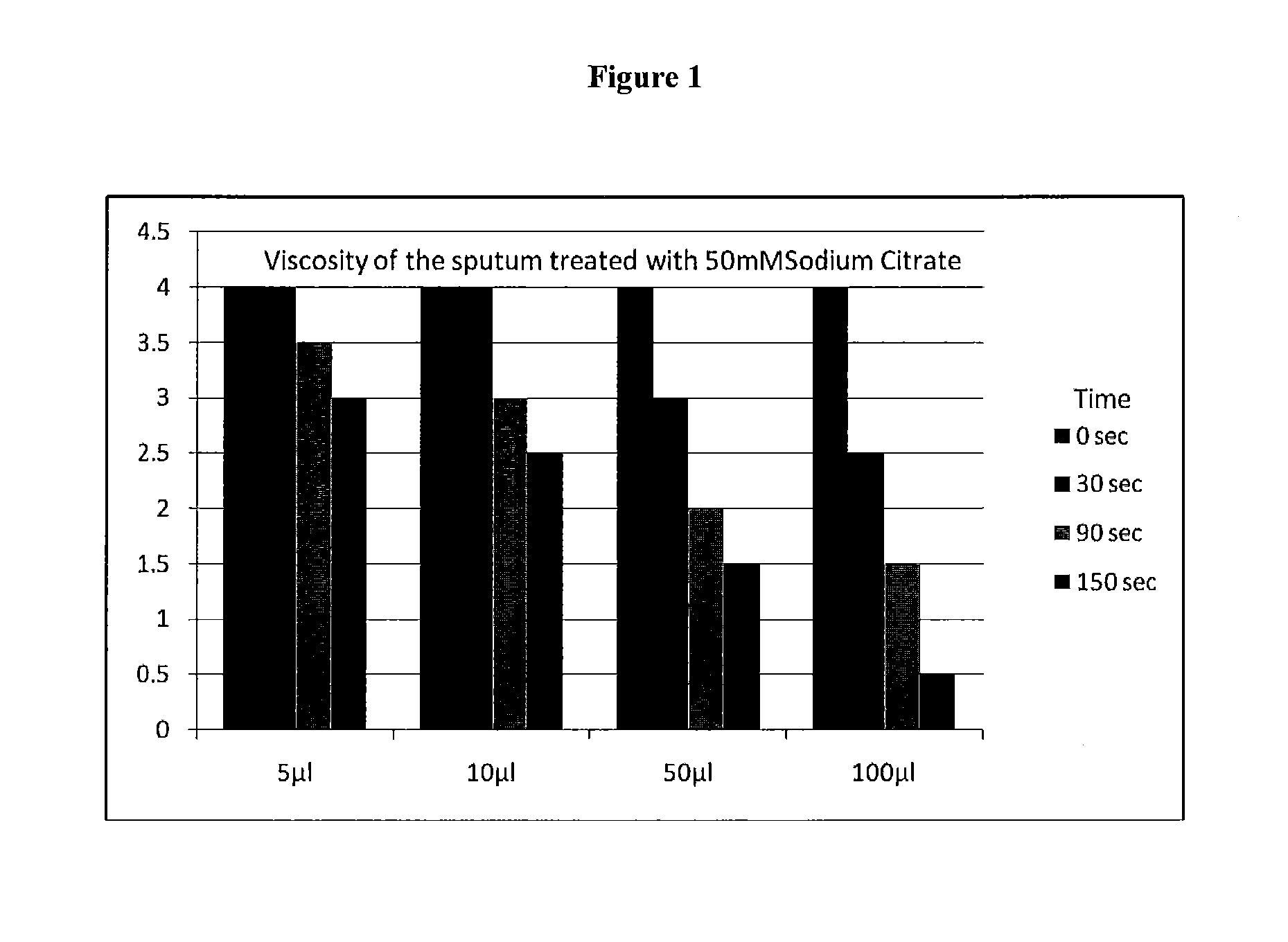Methods and compositions for the disruption of biofilms and treatment of disorders characterized by the presence of biofilms
a biofilm and composition technology, applied in the direction of biocide, plant growth regulators, enzymes, etc., can solve the problems of gastrointestinal dysfunction, severe lung damage, nutritional deficiencies, etc., and achieve the effect of reducing the viscosity and/or cohesiveness of mucus and excessive viscosity
- Summary
- Abstract
- Description
- Claims
- Application Information
AI Technical Summary
Benefits of technology
Problems solved by technology
Method used
Image
Examples
example 1
[0046]The ability of a combination of trisodium citrate and ammonium chloride to treat bacterial and fungal infections in patients with cystic fibrosis was examined as follows.
Study 1
[0047]The subject in this study was a 26 year old female with cystic fibrosis, diagnosed by newborn screening test and confirmed by sweat test and genetic analysis (delta F508 mutation). She had suffered frequent bouts of pulmonary infections associated with the growth of Pseudomonas aeruginosa since the age of seven. This organism was cultured every time a sputum sample was taken, despite frequent courses of oral and intravenous antibiotics, and, over the last decade, almost continuous Tobramycin delivered twice a day by nebulizer. The subject had also received courses of nebulized alpha-dornase to alleviate tenacious sputum, without much effect.
[0048]Before treatment with an isotonic combination of trisodium citrate and ammonium chloride began, her sputum again showed a heavy growth of mucoid Pseudomo...
example 2
[0054]The ability of isotonic trisodium citrate together with 4 mg / mL ammonium chloride (pH 7.14) to dissolve alginate beads was examined as follows.
[0055]2 mL alginate beads were prepared from Alginate 5710 / 10 (airflow 2.455, gelled in calcium chloride for 5 minutes, rinsed and washed with NaCl2, size 600 um). 5 mL Isotonic sodium citrate was added to 2 mL alginate beads and incubated on roller for 2 minutes, rinsed and washed with sodium chloride. 5 mL Isotonic sodium citrate was added to 2 mL alginate beads and incubated on roller for 5 minutes, rinsed and washed with NaCl. 5 mL isotonic sodium citrate plus 4 mg / mL ammonium chloride (pH 7.14) was added to 2 mL alginate beads and incubated on roller for 2 minutes, rinsed and washed with NaCl. 5 mL isotonic sodium citrate plus 4 mg / mL ammonium chloride (pH 7.14) was added to 2 mL alginate beads and incubated on roller for 5 minutes, rinsed and washed with NaCl. All samples were analyzed via light microscopy and also by visual deter...
example 3
[0060]The ability of sodium citrate solution to decrease the viscosity of sputum samples was examined as follows.
[0061]Three different sputum samples were employed: sample 1 was of a runny consistency; sample 2 was of an intermediate consistency; and sample 3 was of a heavy consistency. 100 ul samples were measured and transferred to assay tubes in duplicate (except for sample 1 which was in short supply) and placed in a 37° C. preheated Thermomixer. 10 ul of saline (0.9% NaCl) was used as a negative control. 5 ul, 10 ul, 50 ul or 100 ul of 55 mM aqueous sodium citrate solution was added per tube and mixed (400 rpm). Each tube was checked for pourability, or viscosity, at 30 sec, 90 sec and 150 sec by observing the movement of the sputum sample along the wall of the tube. The pourability of sample 3 was also checked at 5 minutes. The pourability was graded as follows: “0”=no change to “+++>” dissolved. The results of the study are shown below in Table 2 for samples 1-3, and in FIG. ...
PUM
| Property | Measurement | Unit |
|---|---|---|
| volume | aaaaa | aaaaa |
| pH | aaaaa | aaaaa |
| size | aaaaa | aaaaa |
Abstract
Description
Claims
Application Information
 Login to View More
Login to View More - R&D
- Intellectual Property
- Life Sciences
- Materials
- Tech Scout
- Unparalleled Data Quality
- Higher Quality Content
- 60% Fewer Hallucinations
Browse by: Latest US Patents, China's latest patents, Technical Efficacy Thesaurus, Application Domain, Technology Topic, Popular Technical Reports.
© 2025 PatSnap. All rights reserved.Legal|Privacy policy|Modern Slavery Act Transparency Statement|Sitemap|About US| Contact US: help@patsnap.com

